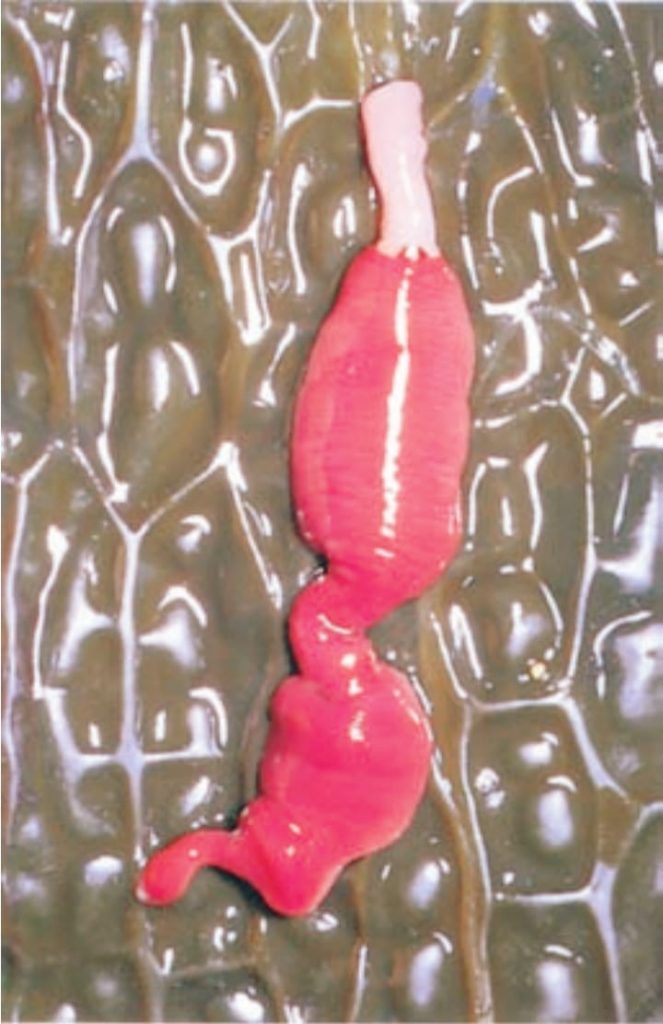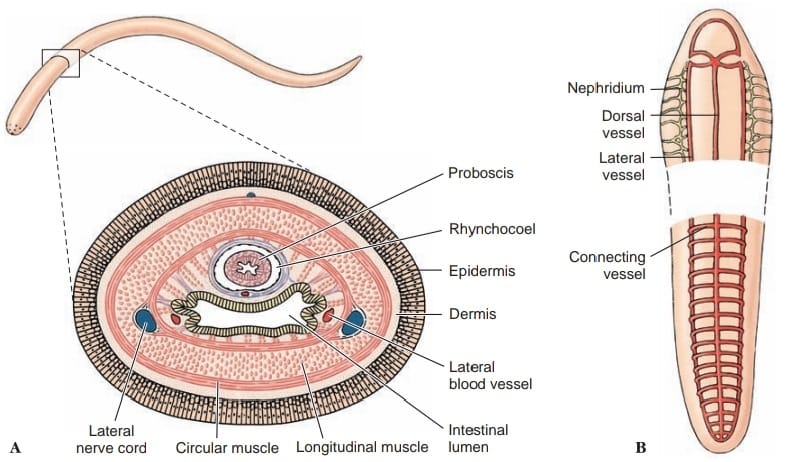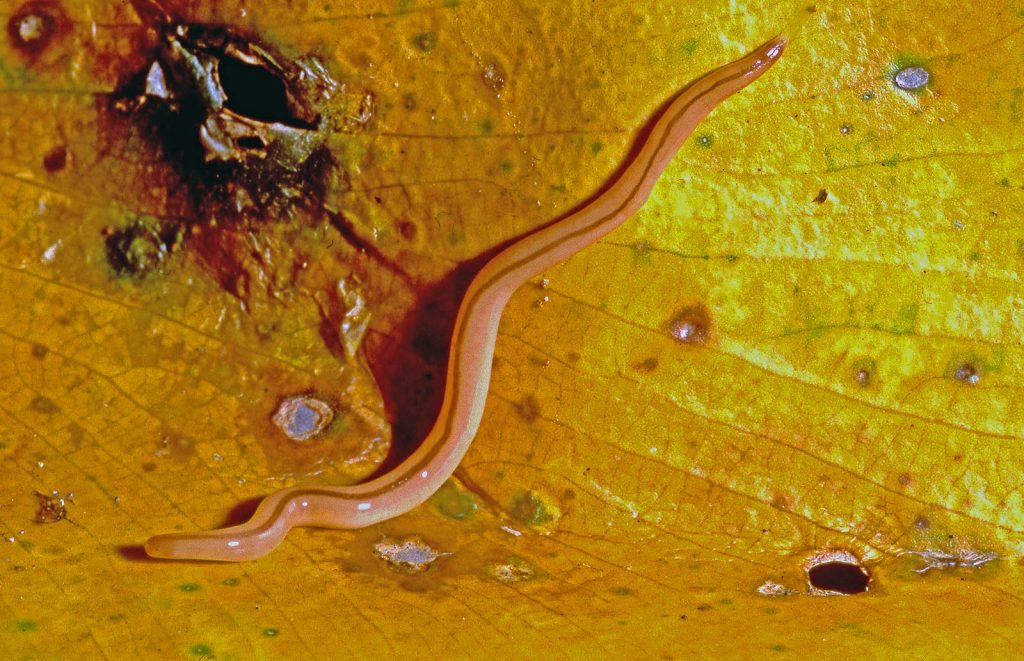Nemerteans (nem-er -te-ans) are often called ribbon worms. Their name (Gr. Nemertes, one of the Nereids, unerring one) refers to the unerring aim of the proboscis, a long muscular tube and that can be thrust out swiftly to grasp their prey. The phylum is also called Rhynchocoela (ring -ko-se -la) (Gr. rhynchos, beak, koilos, hollow), which also refers to the proboscis. They are thread-shaped or ribbon shaped bilaterally symmetrical, triploblastic worms; There are about 1000 species in the group; nearly all are marine.


Nemertean worms are usually less than 20 cm long, although a few are several meters in length . Lineus longissimus (L. linea, line) was reportedly able to stretch up to 60 m in length! Their colors can be bright, although most are dull or pallid. Some live in secreted gelatinous tubes.

With few exceptions, the general body plan of nemerteans is similar to that of turbellarians. The epidermis of nemerteans is ciliated and has many gland cells. There are flame cells in the excretory system. Rhabdites have been found in several nemerteans, including Lineus, but some work indicates that they are not homologous to rhabdites in flatworms. Nemerteans also differ from flatworms in their reproductive system. Ribbon worms are mostly dioecious. In marine forms there is a ciliated larva that has some resemblance to trochophore larvae found in annelids and molluscs.
Nemerteans show some derived features absent from flat worms. The most obvious of these is the eversible proboscis and its sheath, for which there are no counterparts within any other phylum. In the odd genus Gorgonorhynchus (Gr. Gorgo, name of a female monster of terrible aspect, rhynchos, beak, snout) the proboscis is divided into many proboscides, which appear as a mass of wormlike structures when everted. Another difference is the presence of an anus in adults, producing a complete digestive system. A digestive system with an anus is more efficient because ejection of waste materials back through the mouth is not necessary. Ingestion and defecation can occur simultaneously. Nemerteans are also the simplest animals to have a closed loop blood–vascular system.
A few nemerteans occur in moist soil and freshwater. Prostoma rubrum (Gr. pro, before, in front of, stoma, month) which is 20 mm or less in length, is a well-known freshwater species. The larger number of nemertean species are marine; at low tide they are often coiled under stones. It seems probable that they are active at high tide and quiescent at low tide. Some nemerteans such as Cerebratulus (L. cerebrum, brain, ulus, dim. suffix) often live in empty mollusc shells. Small species often live among seaweed, or they may be found swimming near the surface of the water. Nemerteans are often secured by dredging at depths of 5 to 8 m or deeper.
Although a few species are commensals or scavengers, most ribbon worms are active predators on small invertebrates. A few species are specialized egg predators (considered ectoparasites) on brachyuran crabs, and in high numbers can consume all the embryos in their host’s clutch. Many nemerteans are difficult to examine because they are so long and fragile. Amphiporus (Gr. amphi, on both sides, poros, a genus of smaller forms that ranges from 2 to 10 cm in length, is fairly typical of nemertean structure . Its body wall consists of ciliated epidermis and layers of circular and longitudinal muscles . Locomotion consists largely of gliding over a slime track, although larger species move by muscular contractions. Some large species are even capable of undulatory swimming when threatened.

The mouth is anterior and ventral, and the digestive tract is complete, extending the full length of the body and ending at an anus. There are usually no muscles in the gut wall itself; instead cilia move food through the intestine. Digestion is largely extracellular in the gut lumen. The favorite prey of most nemerteans is annelids and other small invertebrates. Their diets may be highly specialized or extremely varied, depending on the species. Some species appear able to detect prey only when they physically bump into it, whereas others are capable of tracking prey over great distances. When prey is encountered, nemerteans seize it with a proboscis that lies in an interior.cavity of its own, the rhynchocoel, above the digestive tract (but not connected with it). The proboscis itself is a long, blind muscular tube that opens at the anterior end at a proboscis pore above the mouth .
Muscular pressure on fluid in the rhynchocoel causes the long tubular proboscis to be everted rapidly through the proboscis pore. Eversion of the proboscis exposes a sharp barb, called a stylet (absent in some nemerteans). The sticky, slime-covered proboscis coils around the prey and stabs it (often repeatedly) with the stylet, while pouring a toxic secretion on the prey . The neurotoxin in some species has recently been identified as tetrodotoxin, commonly known as the poison in puffer fishes. Then, etracting its proboscis, a nemertean draws the prey near its mouth and the subdued prey is swallowed whole.
Nemerteans have a true circulatory system, and blood flow is maintained by a combination of the contractile walls of the vessels and general body movements. As a result the flow is irregular and often reverses direction in the vessels. Two to many flame-bulb protonephridia are closely associated with the circulatory system, so that their function appears to be truly excretory (for disposal of metabolic wastes), in contrast to their apparently osmoregulatory role in Platyhelminthes.
Nemerteans have a pair of nerve ganglia, and one or more pairs of longitudinal nerve cords are connected by transvers nerves. Some species reproduce asexually by fragmentation and regeneration. Nemerteans show a surprising range of sexual reproductive strategies. Most species are dioecious and fertilization is often external, although many exceptions are known: Some species are hermaphroditic, some have internal fertilization, and some even have ovoviviparous development.
Useful External Links
- Ribbon worm by John P. Rafferty
- 14 Fun Facts about Marine Ribbon Worms by Emily Frost
- The Toxins of Nemertean Worms by Malin Strand


